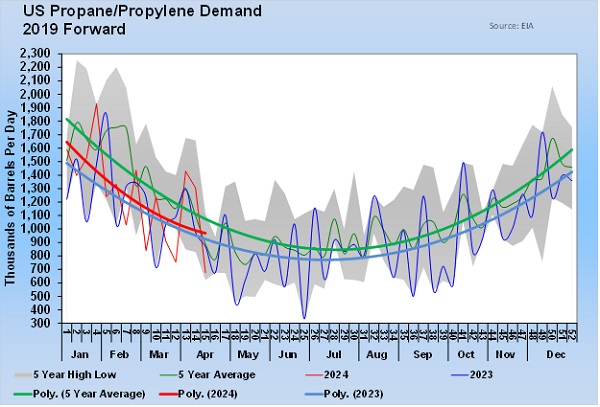Surging propane-to-crude values, inventory dynamics increase upside price risk
In last week’s Trader’s Corner, we looked at the sharp two-week fall in U.S. propane inventory. For the week ending Feb. 5, the Energy Information Administration (EIA) reported a 3.288-million-barrel draw on inventory, well above the 2.329-million-barrel, five-year-average draw for the fifth week of the year.
For the three-week period ending Feb. 5, U.S. propane inventory was down 15.145 million barrels, more than double the 7.452 million barrels averaged over the past five years. The consequences have been significant for the value of propane over that time period.
On Jan. 15, Mont Belvieu and Conway propane traded at 30.25 cents per gallon and 27 cents per gallon, respectively. At the close on Feb. 11, Mont Belvieu propane was valued at 34.875 cents per gallon, an 8 percent gain, and Conway at 31.625 cents per gallon, a 9 percent gain.
Even more dramatic is the change in relative value between propane and West Texas Intermediate (WTI) crude.
The chart above plots what percentage Mont Belvieu propane’s value is compared to the value of WTI crude. Conway’s chart is very similar. The red line for 2016 shows that Mont Belvieu propane went from a value of 43 percent of WTI crude on Jan. 15 (when the string of above-average inventory builds began) to 56 percent on Feb. 11.
Mont Belvieu propane’s relative value to WTI crude is now higher than it was at any time last year and above the five-year average for this point in the year. However, note that propane’s relative value dropped precipitously from the end of February until June of last year. Mont Belvieu propane was at 61.5 cents and 52 percent of WTI crude at the end of last February. By June 8, the price was 34 cents and 25 percent of WTI crude.
Should we expect the same type of drop in prices and relative value this year? From a nominal price standpoint, it is a fairly easy bet that Mont Belvieu will not make the same 27.5-cent drop this year. That would put Mont Belvieu trading at 8.625 cents per gallon. Even at the same 25 percent relationship to WTI crude that was hit last June, crude would have to drop to below $15 per barrel to reach that price.
We do not believe sub-$15 crude and propane at 25 percent of WTI crude are probable. While we might be convinced crude could fall to that level, given current conditions, we are almost certain that propane will not lose much in relative value to crude.
We are expecting a very mild March, so there is a possibility that propane’s relative value could slip a little between now and the end of March. Beyond March, we think the probability of propane trading below 50 percent of the value of crude is low.
U.S. export capacity is now capable of significantly limiting the builds in propane inventory. When propane’s relative value was falling last year, its inventory increased nearly 30 million barrels between its low from March 1 to June 30.
We are fairly certain that rate of build will not occur this year. We think the above-average rate of inventory draw currently going on is a harbinger for light inventory builds this spring and summer.
EIA is showing 294,000 barrels per day (bpd) more exports this year than last year at this time. It is currently projecting U.S. exports at 702,000 bpd compared to 408,000 during the same week last year. However, industry experts estimate that exports were over 950,000 bpd last month.
There are more export projects coming over the next few years that are estimated to increase capacity to 1.5 million bpd. To put that in perspective, U.S. propane production was just 1.610 million bpd last week and has been on the decline since the middle of December when propane production peaked at 1.701 million bpd.
Further, U.S. petrochemicals are increasing the amount of propane they are using as feedstock. The latest data shows they consumed 393,000 bpd in January.
For several years, growth in propane production outpaced our ability to consume it or export it. That is no longer the case. For those reasons, we think it is highly improbable for either propane’s nominal or relative values to decrease to the extent they did last year. We think there may remain some downside risk through March, but even that is not a certainty if inventory draws don’t slow. Beyond March, we project upside price risk for propane will greatly increase.
Propane retailers have the ability to hedge the next three winters of supply, protecting customers and margins from upside price risk. Please consider attending our hedging workshop in April for more details on why upside price risk is increasing and to learn how you can get ahead of what appears to be a developing uptrend in propane prices.
For more Cost Management Solutions analysis of the energy market that helps propane retailers manage their supply sources and make informed purchasing decisions, visit www.lpgasmagazine.com/propane-price-insider/archives/.
















